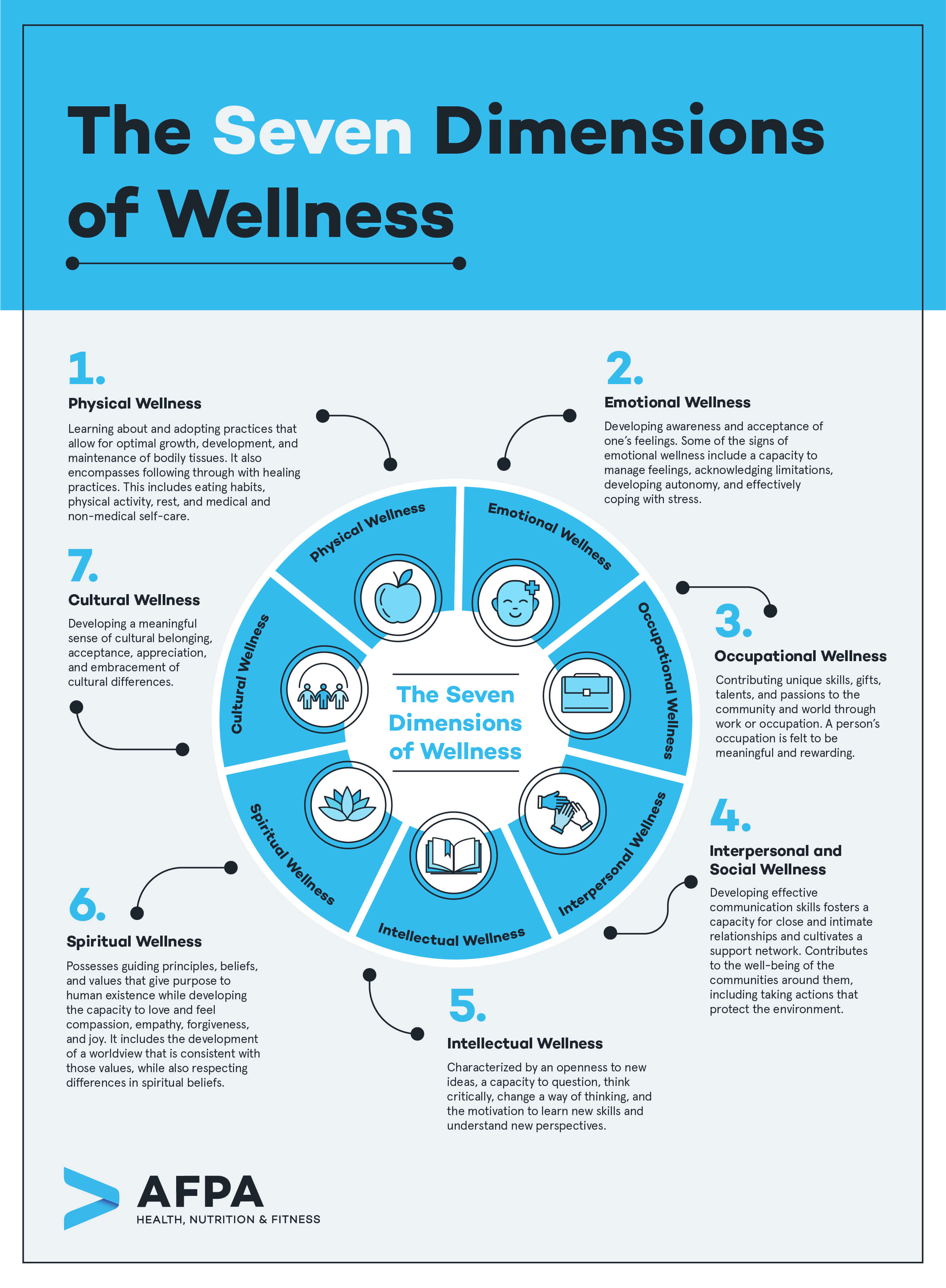Wellness approaches have been elevated across professional health and related fields due to their potential to support people on their pathway to holistic, optimal living.
Conventional health approaches often focus on only physical or emotional well-being. The wellness approach values those two as vital dimensions of well-being; it also recognizes that human wellness is complex and multifaceted. Not only are our bodies and minds important to our well-being but also to our jobs, cultures, and communities.
In this article, we introduce the seven dimensions of wellness and describe how a wellness approach can benefit your coaching business.

Learn How to Become a Certified Holistic Health Coach Online

The Connection Between Health and Wellness
The terms health and wellness are often uttered in the same breath. While the terms are closely related, they are different. The meanings have important implications for how health professionals, including health, wellness, and fitness coaches, guide their clients toward living a life where they feel “well” on their own terms.
To clarify the difference between the two terms, let’s look at some definitions.
Health as a State
The most widely-used definition of health is the one found in the Preamble to the Constitution of the World Health Organization (WHO) adopted by the International Health Conference in 1946:
Health is a state of complete physical, mental, and social well-being and not merely the absence of disease or infirmity.
While health is generally used to refer to physical health, the WHO recognized early on that health as a state of being can only be experienced when a person is mentally and socially well, in addition to being physically well. It is important to note that, while the medical and health sciences have developed useful tools for measuring health, the actual experience and meaning of health may differ widely from person to person.
For example, menopause may be experienced differently by different communities. Cross-cultural perspective studies have demonstrated that women across ethnic groups and nationalities have differing experiences of and views on aging and menopause. An exploratory study examined the impact of country of residence on menopausal symptoms and found that the symptoms leading to, during, and after menopause differed significantly.
Even within the US, different ethnic and racial groups had varying attitudes toward menopause. One study found that African American women tended to have a more positive attitude toward menopause, while less acculturated Chinese American and Japanese American women tended to have the least positive attitude toward menopause.
After reflecting on this example, it may become clearer how experiences with and meanings of health can differ across cultures, communities, and between individuals. As a result, achieving a state of well-being, as stated in the WHO definition of health, will naturally be significantly different for different people.
Wellness Is a Process
Unlike for health, wellness doesn’t have a definition developed by an international agency with political and legislative implications.
However, there are several organizations dedicated to the understanding, study, and promotion of wellness across nations, cultures, and environments. One of the most commonly cited definitions of wellness is that of the National Wellness Institute:
Wellness is an active process through which people become aware of, and make choices toward, a more successful existence.
The keyword of this definition is process. Unlike health, wellness isn’t a state of being but rather a journey that includes becoming aware of the many interconnected factors that lead to a more successful existence. This definition highlights not only a subjective experience of wellness but also the importance of 1) becoming aware of the different aspects of wellness, and 2) making choices that help individuals feel they are living the life that essentially makes them feel good.
While this is a useful definition, it is important to keep in mind that it implies that wellness is the result of a series of choices. While choice is one vital factor of being able to actively work toward wellness, there are multiple elements affecting wellness that are out of an individual’s control. Socio, environmental, and psychological determinants of health and well-being represent insurmountable barriers to wellness, and these are largely out of an individual’s control.
A person or community embarks on a wellness journey when they become aware of the several dimensions that affect wellness.
The Seven Dimensions of Wellness
The National Wellness Institute promotes six dimensions of wellness: emotional, occupational, physical, social, intellectual, and spiritual.
By addressing the dimensions of wellness in our lives, we build a holistic sense of wellness that speaks to individual and community fulfillment. Western Connecticut State University (WCSU) adds cultural wellness as the seventh dimension of wellness to shed light on the vital role of cultural belonging, acceptance, appreciation, and the embracement of cultural differences in wellness. WCSU also includes environmental wellness instead of occupational wellness in their definition. In the descriptions below, environmental wellness is encompassed in social, interpersonal wellness.
Below is a brief description of the seven areas of wellness:
- Physical wellness: Learning about and adopting practices that allow for optimal growth, development, and maintenance of bodily tissues. It also encompasses following through with healing practices. This includes eating habits, physical activity, rest, and medical and non-medical self-care.
- Emotional wellness: Developing awareness and acceptance of one’s feelings. Some of the signs of emotional wellness include a capacity to manage feelings, acknowledging limitations, developing autonomy, and effectively coping with stress.
- Occupational wellness: Contributing unique skills, gifts, talents, and passions to the community and world through work or occupation. A person’s occupation is felt to be meaningful and rewarding.
- Interpersonal and social wellness: Developing effective communication skills fosters a capacity for close and intimate relationships and cultivates a support network. Contributes to the well-being of the communities around them, including taking actions that protect the environment.
- Intellectual wellness: Characterized by an openness to new ideas, a capacity to question, think critically, change a way of thinking, and the motivation to learn new skills and understand new perspectives.
- Spiritual wellness: Possesses guiding principles, beliefs, and values that give purpose to human existence while developing the capacity to love and feel compassion, empathy, forgiveness, and joy. It includes the development of a worldview that is consistent with those values while also respecting differences in spiritual beliefs.
- Cultural wellness: Developing a meaningful sense of cultural belonging, acceptance, appreciation, and embracement of cultural differences.
Main Takeaway: The Benefits of Applying the Dimensions of Wellness to Your Coaching Program
The seven dimensions of wellness model allows you to gain a more holistic understanding of health. As the National Wellness Institute states, “Applying a wellness approach can be useful in nearly every human endeavor.” Because of its flexible, subjective nature, it can be a pathway to optimal human living.
Applying a wellness approach to your coaching program can be a way to:
- Help clients achieve their full human potential
- Recognize, address, and value the whole person in their many dimensions
- Give space to clients for self-determination of what health and wellness look like
- Value the physical and emotional dimensions of wellness while also looking to other dimensions for understanding and healing
- Affirm and mobilize people’s strengths




